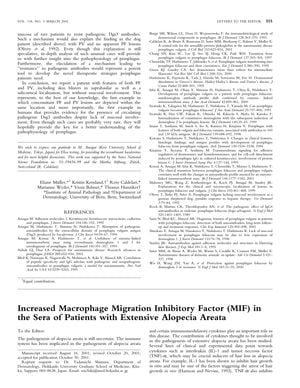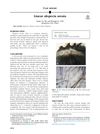Increased Macrophage Migration Inhibitory Factor in the Sera of Patients with Extensive Alopecia Areata
macrophage migration inhibitory factor MIF alopecia areata serum MIF concentration immunohistochemical analysis perifollicular-infiltrated lymphocytes telogen hair follicles proinflammatory cytokines IL-1 TNF-α inflammatory hair loss MIF alopecia areata hair follicles cytokines inflammatory hair loss

TLDR Patients with severe alopecia areata have higher levels of MIF, which decrease after successful treatment.
The study found that patients with extensive alopecia areata had significantly elevated serum levels of macrophage migration inhibitory factor (MIF) compared to those with mild alopecia areata and healthy individuals. The mean serum MIF concentration in extensive alopecia areata patients was 50.6 ± 5.7 ng/ml, while it was 15.1 ± 2.1 ng/ml in mild cases and 8.9 ± 1.3 ng/ml in healthy individuals (p < 0.001). After successful hair regrowth treatment, MIF levels in extensive alopecia areata patients decreased significantly. Immunohistochemical analysis showed intense MIF staining in perifollicular-infiltrated lymphocytes of telogen hair follicles. The findings suggested that MIF, along with proinflammatory cytokines IL-1 and TNF-α, might play a crucial role in the pathophysiology of inflammatory hair loss in alopecia areata, and controlling MIF production could have therapeutic implications.


